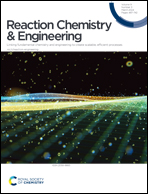Phosphoryl- or phosphinoyl-functionalized benzo[de]isoquinolinones: synthesis, experimental design, mechanism and biological activity†
Abstract
A propylphosphonic anhydride (T3P®)-mediated new multicomponent method was developed for the synthesis of benzo[de]isoquinolinones bearing a phosphonate or a phosphine oxide moiety as a new family of compounds. The one-pot three-component reaction of 1,8-naphthalaldehydic acid, primary amines and dialkyl phosphites or secondary phosphine oxides was carried out under mild conditions at low or ambient temperature for short reaction times. The synthesis of benzo[de]isoquinolin-1-one-3-phosphonates was optimized by a statistical experimental design model and response surface methodology. The synthesis of benzo[de]isoquinolin-1-one-3-phosphine oxides was followed by in situ Fourier transform (FT)-IR spectroscopy to investigate the reaction mechanism and the role of T3P®. Moreover, the in vitro cytotoxicity of benzo[de]isoquinolin-1-one-3-phosphine oxides was also tested on four different cancer and healthy cell lines. One of eight compounds showed promising activity on all the three cancer cell lines and was the least toxic against healthy cells; furthermore it was more active than the reference foretinib.
![Graphical abstract: Phosphoryl- or phosphinoyl-functionalized benzo[de]isoquinolinones: synthesis, experimental design, mechanism and biological activity](/en/Image/Get?imageInfo.ImageType=GA&imageInfo.ImageIdentifier.ManuscriptID=D3RE00489A&imageInfo.ImageIdentifier.Year=2024)


 Please wait while we load your content...
Please wait while we load your content...